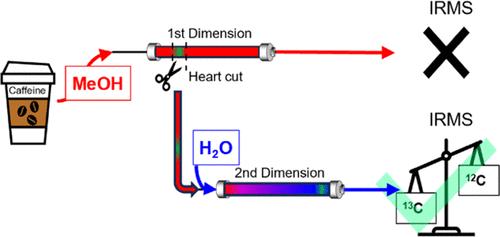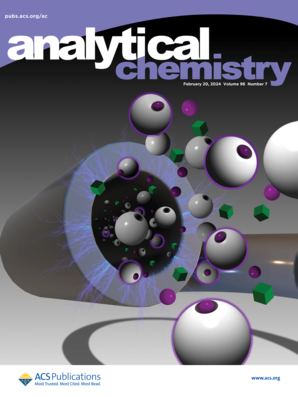Two-Dimensional Liquid Chromatography-Isotope Ratio Mass Spectrometry Opens New Possibilities in the Field of Compound-Specific Stable Isotope Analysis
IF 6.7
1区 化学
Q1 CHEMISTRY, ANALYTICAL
引用次数: 0
Abstract
Compound-specific stable isotope analysis (CSIA) using liquid chromatography-isotope ratio mass spectrometry (LC-IRMS) is a powerful tool for determining the isotopic composition of carbon in analytes from complex mixtures. However, LC-IRMS methods are constrained to fully aqueous eluents. Previous efforts to overcome this limitation were unsuccessful, as the use of organic eluents in LC-IRMS was deemed impossible. In our study, we developed a two-dimensional (2D) LC-IRMS method that, for the first time, enables the use of organic-containing eluents in an LC-IRMS setting. Initial experiments with caffeine were performed using a sample loop modulator with 20% methanol in the mobile phase of the first dimension, while separating the organic fraction from the analyte in the second dimension. Comparing results with one-dimensional (1D) LC-IRMS methods showed high precision with δ13C values in 2D measurements (−34.98 ± 0.04 ‰) closely matching 1D results (−34.95 ± 0.12 ‰). In the next step, incorporation of an at-column dilution (ACD) modulator allowed for the successful use of methanol concentrations up to 40% in the first dimension, with the ACD modulator effectively mitigating both peak fronting and carbon background interference, without losing any precision or accuracy of the measurements (δ13CCaffeine = −34.92 ± 0.03 ‰). All developed methods showed a method detection limit lower than 5 mg of carbon L–1 (mgC L–1), which is a major improvement compared with previous studies on caffeine analysis with LC-IRMS. This proof-of-concept study on 2D-LC-IRMS opens vast new possibilities for future CSIA research across diverse fields, including environmental science, pharmaceuticals, and food chemistry.

求助全文
约1分钟内获得全文
求助全文
来源期刊

Analytical Chemistry
化学-分析化学
CiteScore
12.10
自引率
12.20%
发文量
1949
审稿时长
1.4 months
期刊介绍:
Analytical Chemistry, a peer-reviewed research journal, focuses on disseminating new and original knowledge across all branches of analytical chemistry. Fundamental articles may explore general principles of chemical measurement science and need not directly address existing or potential analytical methodology. They can be entirely theoretical or report experimental results. Contributions may cover various phases of analytical operations, including sampling, bioanalysis, electrochemistry, mass spectrometry, microscale and nanoscale systems, environmental analysis, separations, spectroscopy, chemical reactions and selectivity, instrumentation, imaging, surface analysis, and data processing. Papers discussing known analytical methods should present a significant, original application of the method, a notable improvement, or results on an important analyte.
 求助内容:
求助内容: 应助结果提醒方式:
应助结果提醒方式:


